Omega-6 fats for the primary and secondary prevention of cardiovascular disease
- PMID: 30488422
- PMCID: PMC6516799
- DOI: 10.1002/14651858.CD011094.pub4
Omega-6 fats for the primary and secondary prevention of cardiovascular disease
Abstract
Background: Omega-6 fats are polyunsaturated fats vital for many physiological functions, but their effect on cardiovascular disease (CVD) risk is debated.
Objectives: To assess effects of increasing omega-6 fats (linoleic acid (LA), gamma-linolenic acid (GLA), dihomo-gamma-linolenic acid (DGLA) and arachidonic acid (AA)) on CVD and all-cause mortality.
Search methods: We searched CENTRAL, MEDLINE and Embase to May 2017 and clinicaltrials.gov and the World Health Organization International Clinical Trials Registry Platform to September 2016, without language restrictions. We checked trials included in relevant systematic reviews.
Selection criteria: We included randomised controlled trials (RCTs) comparing higher versus lower omega-6 fat intake in adults with or without CVD, assessing effects over at least 12 months. We included full texts, abstracts, trials registry entries and unpublished studies. Outcomes were all-cause mortality, CVD mortality, CVD events, risk factors (blood lipids, adiposity, blood pressure), and potential adverse events. We excluded trials where we could not separate omega-6 fat effects from those of other dietary, lifestyle or medication interventions.
Data collection and analysis: Two authors independently screened titles/abstracts, assessed trials for inclusion, extracted data, and assessed risk of bias of included trials. We wrote to authors of included studies. Meta-analyses used random-effects analysis, while sensitivity analyses used fixed-effects and limited analyses to trials at low summary risk of bias. We assessed GRADE quality of evidence for 'Summary of findings' tables.
Main results: We included 19 RCTs in 6461 participants who were followed for one to eight years. Seven trials assessed the effects of supplemental GLA and 12 of LA, none DGLA or AA; the omega-6 fats usually displaced dietary saturated or monounsaturated fats. We assessed three RCTs as being at low summary risk of bias.Primary outcomes: we found low-quality evidence that increased intake of omega-6 fats may make little or no difference to all-cause mortality (risk ratio (RR) 1.00, 95% confidence interval (CI) 0.88 to 1.12, 740 deaths, 4506 randomised, 10 trials) or CVD events (RR 0.97, 95% CI 0.81 to 1.15, 1404 people experienced events of 4962 randomised, 7 trials). We are uncertain whether increasing omega-6 fats affects CVD mortality (RR 1.09, 95% CI 0.76 to 1.55, 472 deaths, 4019 randomised, 7 trials), coronary heart disease events (RR 0.88, 95% CI 0.66 to 1.17, 1059 people with events of 3997 randomised, 7 trials), major adverse cardiac and cerebrovascular events (RR 0.84, 95% CI 0.59 to 1.20, 817 events, 2879 participants, 2 trials) or stroke (RR 1.36, 95% CI 0.45 to 4.11, 54 events, 3730 participants, 4 trials), as we assessed the evidence as being of very low quality. We found no evidence of dose-response or duration effects for any primary outcome, but there was a suggestion of greater protection in participants with lower baseline omega-6 intake across outcomes.Additional key outcomes: we found increased intake of omega-6 fats may reduce myocardial infarction (MI) risk (RR 0.88, 95% CI 0.76 to 1.02, 609 events, 4606 participants, 7 trials, low-quality evidence). High-quality evidence suggests increasing omega-6 fats reduces total serum cholesterol a little in the long term (mean difference (MD) -0.33 mmol/L, 95% CI -0.50 to -0.16, I2 = 81%; heterogeneity partially explained by dose, 4280 participants, 10 trials). Increasing omega-6 fats probably has little or no effect on adiposity (body mass index (BMI) MD -0.20 kg/m2, 95% CI -0.56 to 0.16, 371 participants, 1 trial, moderate-quality evidence). It may make little or no difference to serum triglycerides (MD -0.01 mmol/L, 95% CI -0.23 to 0.21, 834 participants, 5 trials), HDL (MD -0.01 mmol/L, 95% CI -0.03 to 0.02, 1995 participants, 4 trials) or low-density lipoprotein (MD -0.04 mmol/L, 95% CI -0.21 to 0.14, 244 participants, 2 trials, low-quality evidence).
Authors' conclusions: This is the most extensive systematic assessment of effects of omega-6 fats on cardiovascular health, mortality, lipids and adiposity to date, using previously unpublished data. We found no evidence that increasing omega-6 fats reduces cardiovascular outcomes other than MI, where 53 people may need to increase omega-6 fat intake to prevent 1 person from experiencing MI. Although benefits of omega-6 fats remain to be proven, increasing omega-6 fats may be of benefit in people at high risk of MI. Increased omega-6 fats reduce serum total cholesterol but not other blood fat fractions or adiposity.
Conflict of interest statement
LH: WHO provided funding to the University of East Anglia to support this review update. Some of this funding was used to fund LH's employment. WHO also funded LH's attendance at WHO NUGAG Subgroup on Diet and Health and CODEX meetings to discuss and present this review and others in this set. No other conflicts known.
LA‐K: none known.
ASA: WHO provided funding to the University of East Anglia to support this review update. Some of this funding was used to fund ASA's employment. WHO also funded ASA's attendance at WHO NUGAG Subgroup on Diet and Health meetings to discuss and present this review and others in this set. No other conflicts known.
KR: none known.
JSB: WHO provided funding to the University of East Anglia to support this review update. Some of this funding was used to fund JSB's employment. No other conflicts known.
TJB: WHO provided funding to the University of East Anglia to support this review update. Some of this funding was used to fund TJB's employment. No other conflicts known.
SMAA: WHO provided funding to the University of East Anglia to support this review update. Some of this funding was used to fund SMAA's employment. No other conflicts known.
ATO'B: none known; carried out as part of his MBBS degree at the University of East Anglia.
LEW: none known; carried out as part of her MBBS degree at the University of East Anglia.
DHD: none known; carried out as part of her MBBS degree at the University of East Anglia.
FS: WHO provided funding to the University of East Anglia to support this review update. Some of this funding was used to fund FS's employment. No other conflicts known.
KHOD: WHO provided funding to the University of East Anglia to support this review update. Some of this funding was used to fund KHOD's employment. No other conflicts known.
Figures

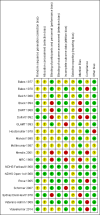






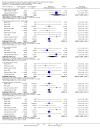











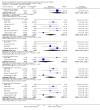









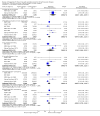











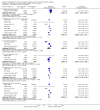






























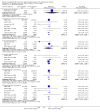















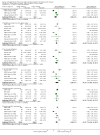

















Update of
-
Omega-6 fats for the primary and secondary prevention of cardiovascular disease.Cochrane Database Syst Rev. 2018 Jul 18;7(7):CD011094. doi: 10.1002/14651858.CD011094.pub3. Cochrane Database Syst Rev. 2018. Update in: Cochrane Database Syst Rev. 2018 Nov 29;11:CD011094. doi: 10.1002/14651858.CD011094.pub4. PMID: 30019765 Free PMC article. Updated.
References
References to studies included in this review
Bates 1977 {published data only (unpublished sought but not used)}
-
- Dworkin RH, Bates D, Millar JH, Paty DW. Linoleic acid and multiple sclerosis: a reanalysis of three double‐blind trials. Neurology 1984;34(11):1441‐5. - PubMed
Bates 1978 {published data only (unpublished sought but not used)}
-
- Dworkin RH, Bates D, Millar JH, Paty DW. Linoleic acid and multiple sclerosis: a reanalysis of three double‐blind trials. Neurology 1984;34(11):1441‐5. - PubMed
Belch 1988 {published and unpublished data}
-
- Belch JJ, Ansell D, Madhok R, O'Dowd A, Sturrock RD. Effects of altering dietary essential fatty acids on requirements for non‐steroidal anti‐inflammatory drugs in patients with rheumatoid arthritis: a double blind placebo controlled study. Annals of the Rheumatic Diseases 1988;47(2):96‐104. - PMC - PubMed
Black 1994 {published and unpublished data}
-
- Black HS, Herd JA, Goldberg LH, Wolf‐JE J, Thornby JI, Rosen T, et al. Effect of a low‐fat diet on the incidence of actinic keratosis. New England Journal of Medicine 1994;330(18):1272‐5. - PubMed
-
- Black HS, Thornby JI, Wolf‐JE J, Goldberg LH, Herd JA, Rosen T, et al. Evidence that a low‐fat diet reduces the occurrence of non‐melanoma skin cancer. International Journal of Cancer 1995;62(2):165‐9. - PubMed
-
- Jaax S, Scott LW, Wolf‐JE J, Thornby JI, Black HS. General guidelines for a low‐fat diet effective in the management and prevention of nonmelanoma skin cancer. Nutrition and Cancer 1997;27(2):150‐6. - PubMed
DART 1989 {published and unpublished data}
-
- Burr ML, Fehily AM. Fish and the heart. Lancet 1989;ii:1450‐2. - PubMed
-
- Burr ML, Fehily AM, Gilbert JF, Rogers S, Holliday RM, Sweetnam PM, et al. Effects of changes in fat, fish, and fibre intakes on death and myocardial reinfarction: diet and reinfarction trial (DART). Lancet 1989;2(8666):757‐61. - PubMed
-
- Burr ML, Fehily AM, Rogers S, Welsby E, King S, Sandham S. Diet and reinfarction trial (DART): design, recruitment, and compliance. European Heart Journal 1989;10(6):558‐67. - PubMed
-
- Burr ML, Holliday RM, Fehily AM, Whitehead PJ. Haematological prognostic indices after myocardial infarction: evidence from the diet and reinfarction trial (DART). European Heart Journal 1992;13(2):166‐70. - PubMed
-
- Burr ML, Sweetham PM, Fehily AM. Diet and reinfarction (letter). European Heart Journal 1994;15(8):1152‐3. - PubMed
Dullart 1992 {published data only (unpublished sought but not used)}
-
- Dullaart RP, Beusekamp BJ, Meijer S, Hoogenberg K, Doormaal JJ, Sluiter WJ. Long‐term effects of linoleic‐acid‐enriched diet on albuminuria and lipid levels in type 1 (insulin‐dependent) diabetic patients with elevated urinary albumin excretion. Diabetologia 1992;35(2):165‐72. [PUBMED: 1547922] - PubMed
GLAMT 1993 {published data only}
-
- Keen H, Payan J, Allawi J, Walker J, Jamal GA, Weir AI, et al. Treatment of diabetic neuropathy with gamma‐linolenic acid. The gamma‐Linolenic Acid Multicenter Trial Group. Diabetes Care 1993;16(1):8‐15. - PubMed
Houtsmuller 1979 {published data only}
-
- Houtsmuller AJ, Zahn KJ, Henkes HE. Unsaturated fats and progression of diabetic retinopathy. Documenta Ophthalmologia 1979;48(2):363‐71. - PubMed
-
- Houtsmuller AJ, Hal‐Ferwerda J, Zahn KJ, Henkes HE. Favourable influences of linoleic acid on the progression of diabetic micro‐ and macroangiopathy. Nutrition and Metabolism 1980;24(Suppl 1):105‐18. - PubMed
-
- Houtsmuller AJ, Hal‐Ferwerda J, Zahn KJ, Henkes HE. Influence of different diets on the progression of diabetic retinopathy. Progress in Food Nutritition and Science 1980;4(5):41‐6. - PubMed
Mansel 1990 {published data only (unpublished sought but not used)}
-
- Mansel RE, Gateley CA, Harrison BJ, Melhuish J, Sheridan W, Pye JK, et al. Effects and tolerability of n‐6 essential fatty acid supplementation in patients with recurrent breast cysts ‐‐ a randomized double‐blind placebo‐controlled trial. Journal of Nutritional Medicine 1990;1(3):195.
-
- Mansel RE, Harrison BJ, Melhuish J, Sheridan W, Pye JK, Pritchard G, et al. A randomized trial of dietary intervention with essential fatty acids in patients with categorized cysts. Annals of the New York Academy of Sciences 1990;586:288‐94. - PubMed
-
- Mansel RE, Pye JK, Hughes LE. Effects of essential fatty acids on cyclical mastalgia and noncyclical breat disorders. In: Horrobin DE editor(s). Omega‐6 Essential Fatty Acids: Pathophysiology and Roles in Clinical Medicine. New York: Wiley‐Liss, 1990:557‐66.
McIllmurray 1987 {published data only (unpublished sought but not used)}
Mendis 2001 {published data only}
-
- Mendis S, Samarajeewa U, Thattil RO. Coconut fat and serum lipoproteins: effects of partial replacement with unsaturated fats. British Journal of Nutrition 2001;85(5):583‐9. - PubMed
MRC 1968 {published and unpublished data}
NDHS Faribault 1968 {published data only (unpublished sought but not used)}
-
- Anon. The National Diet‐Heart Study. Nutrition Reviews 1968;26(5):133‐6. - PubMed
-
- Baker BM, Frantz ID Jr, Keys A, Kinsell LW, Page IH, Stamler J, et al. The National Diet‐Heart Study: an initial report. JAMA 1963;185:105‐6. - PubMed
-
- Brown HB. The National Diet Heart Study ‐ implications for dietitians and nutritionists. Journal of the American Dietetic Association 1968;52:279‐87. - PubMed
-
- Ederer F, Leren P, Turpeinen O, Frantz ID Jr. Cancer among men on cholesterol‐lowering diets: Eperience from five clinical trials. Lancet 1971;298(7717):203‐6. - PubMed
-
- NDHS Research Group. The National Diet‐Heart Study final report. Circulation 1968;37(II):1‐428. - PubMed
NDHS Open 1st 1968 {published data only (unpublished sought but not used)}
-
- Anon. The National Diet‐Heart Study. Nutrition Reviews 1968;26(5):133‐6. - PubMed
-
- Baker BM, Frantz ID Jr, Keys A, Kinsell LW, Page IH, Stamler J, et al. The National Diet‐Heart Study: An initial report. JAMA 1963;185:105‐6. - PubMed
-
- Brown HB. The National Diet Heart Study ‐ implications for dietitians and nutritionists. Journal of the American Dietetic Association 1968;52:279‐87. - PubMed
-
- Ederer F, Leren P, Turpeinen O, Frantz ID Jr. Cancer among men on cholesterol‐lowering diets: Eperience from five clinical trials. Lancet 1971;298(7717):203‐206. - PubMed
-
- NDHS Research Group. The National Diet‐Heart Study final report. Circulation 1968;37(II):1‐428. - PubMed
Rose 1965 {published data only}
Schirmer 2007 {published data only (unpublished sought but not used)}
-
- Schirmer MA, Phinney SD. Gamma‐linolenate reduces weight regain in formerly obese humans. Journal of Nutrition 2007;137(6):1430‐5. [PUBMED: 17513402] - PubMed
Sydney Diet‐Heart 1978 {published and unpublished data}
-
- Blacket RB, Leelarthaepin B, McGilchrist C, Palmer AJ, Woodhill JM. The synergistic effect of weight loss and changes in dietary lipids on the serum cholesterol of obese men with hypercholesterolaemia: implications for prevention of coronary heart disease. Australian and New Zealand Journal of Medicine 1979;9:521‐9. - PubMed
-
- Ramsden CE, Zamora D, Leelarthaepin B, Majchrzak‐Hong SF, Faurot KR, Suchindran CM, et al. Use of dietary linoleic acid for secondary prevention of coronary heart disease and death: evaluation of recovered data from the Sydney Diet Heart Study and updated meta‐analysis. (Erratum appears in BMJ. 2013;346:f903). BMJ 2013;346:e8707. - PMC - PubMed
-
- Woodhill JM, Palmer AJ, Leelarthaepin B, McGilchrist C, Blacket RB. Low fat, low cholesterol diet in secondary prevention of coronary heart disease. Advances in Experimental Medicine and Biology 1978;109:317‐30. - PubMed
Veterans Admin 1969 {published data only (unpublished sought but not used)}
-
- Dayton S, Hashimoto S, Dixon W, Pearce ML. Composition of lipids in human serum and adipose tissue during prolonged feeding of a diet high in unsaturated fat. Journal of Lipid Research 1966;7:103‐11. - PubMed
-
- Dayton S, Hashimoto S, Pearce ML. Adipose tissue linoleic acid as a criterion of adherence to a modified diet. Journal of Lipid Research 1967;8:508‐10. - PubMed
-
- Dayton S, Hashimoto S, Pearce ML. Influence of a diet high in unsaturated fat upon composition of arterial tissue and atheromata in man. Circulation 1965;32:911‐24. - PubMed
-
- Dayton S, Hashimoto S, Rosenblum D, Pearce M. Vitamin E status of humans during prolonged feeding of unsaturated fats. Journal of Laboratory and Clinical Medicine 1965;65(5):739‐47. - PubMed
-
- Dayton S, Pearce ML. Diet and atherosclerosis. Lancet 1970;1(644):473‐4. - PubMed
Vijayakumar 2014 {published and unpublished data}
-
- Nandakumar S, Vijayakumar M, Krishnan S. Coconut oil vs sunflower oil in atherosclerosis. Challenges in dietary intervention. Indian Heart Journal 2014;66:S11.
-
- Vijayakumar M, Krishnaan S, Sundram KR, Vasudevan DM, Nandakumar S. What oil in patients with established coronary artery disease‐outcomes of two year dietary intervention with coconut oil & sunflower oil. Indian Heart Journal 2014;66:S12.
-
- Vijayakumar M, Vasudevan DM, Sundaram KR, Krishnan S, Vaidyanathan K, Nandakumar S, et al. A randomized study of coconut oil versus sunflower oil on cardiovascular risk factors in patients with stable coronary heart disease. Indian Heart Journal 2016;68:498‐506. [DOI: 10.1016/j.ihj.2015.10.384] - DOI - PMC - PubMed
References to studies excluded from this review
Bierenbaum 1963 {published data only}
-
- Bierenbaum ML, Green DP, Gherman C, Florin A, Caidwell AB. The effects of two low fat dietary patterns on the blood cholesterol level of young male coronary patients. Journal of Chronic Diseases 1963;16(10):1073‐83. - PubMed
Bramkamp 1974 {published data only}
-
- Bramkamp K, Wirths W. Influence of linoleic acid enriched margarine on serum cholesterol levels in the elderly [Über den Einfluß von linolsäurereicher Margarine auf den Serumcholesterinspiegel älterer Menschen]. Zeitschrift für Ernährungswissenschaft 1974;13(1‐2):59‐68. - PubMed
Dembinska‐Kiec 2010 {published data only}
-
- Dembinska‐Kiec A, Malczewska‐Malec M, Roche H, Leszczynska‐Golabek I, Hartwich J, Wybranska I, et al. The effect of the n‐3/n‐6 PUFA ratio on the transformation of postprandial state proatherogenic LDL phenotype and oxidative stress parameters. Atherosclerosis Supplements 2010;11(2):129‐30.
Dembinska‐Kiec 2011 {published data only}
-
- Dembinska‐Kiec A, Malczewska‐Malec M, Hartwich J, Wnek D, Goralska J, Kiec‐Wilk B, et al. The effect of dietary intervention on proatherogenic profile of lipoproteins and the blood oxidative stress parameters measured in the course of postprandial lipemia: Lipgene study. Journal of Diabetes 2011;3(s1):28.
Elisha 2011 {published data only}
-
- Elisha B, Guebre‐Egziabher F, Vidal H, Bastard J, Laville M, Rabasa‐Lhoret R. From French to Mediterranean diet: importance of the omega‐6/omega‐3 fatty acids ratio. World Review of Nutrition and Dietetics 2011;102:81‐91. - PubMed
Finnegan 2003a {published data only}
-
- Finnegan YE, Howarth D, Minihane AM, Kew S, Miller GJ, Calder PC, et al. Plant and marine derived (n‐3) polyunsaturated fatty acids do not affect blood coagulation and fibrinolytic factors in moderately hyperlipidemic humans. Journal of Nutrition 2003;133(7):2210‐3. - PubMed
Finnegan 2003b {published data only}
-
- Finnegan YE, Minihane AM, Leigh‐Firbank EC, Kew S, Meijer GW, Muggli R, et al. Plant‐ and marine‐derived n‐3 polyunsaturated fatty acids have differential effects on fasting and postprandial blood lipid concentrations and on the susceptibility of LDL to oxidative modification in moderately hyperlipidemic subjects. American Journal of Clinical Nutrition 2003;77(4):783‐95. - PubMed
Finnish Mental Hosp 1972 {published data only}
-
- Miettinen M, Turpeinen O, Karvonen MJ, Elosuo R, Paavilainen E. Effect of cholesterol‐lowering diet on mortality from coronary heart‐disease and other causes: a twelve‐year clinical trial in men and women. Lancet 1972;2(782):835‐8. - PubMed
-
- Miettinen M, Turpeinen O, Karvonen MJ, Pekkarinen M, Paavilainen E, Elosuo R. Dietary prevention of coronary heart disease in women: the Finnish mental hospital study. International Journal of Epidemiology 1983;12(1):17‐25. - PubMed
-
- Turpeinen O, Miettinen M, Karvonen M, Roine P, Pekkarinen M, Lehtosuo EJ, et al. Dietary prevention of coronary heart disease: long‐term experiment. I. Observations on male subjects. American Journal of Clinical Nutrition 1968;21(4):255‐76. - PubMed
Gaullier 2004 {published data only}
-
- Gaullier JM, Halse J, Høye K, Kristiansen K, Fagertun H, Vik H, et al. Conjugated linoleic acid supplementation for 1 y reduces body fat mass in healthy overweight humans. American Journal of Clinical Nutrition 2004;79(6):1118‐25. - PubMed
Gaullier 2005 {published data only}
-
- Gaullier JM, Halse J, Høye K, Kristiansen K, Fagertun H, Vik H, et al. Supplementation with conjugated linoleic acid for 24 months is well tolerated by and reduces body fat mass in healthy, overweight humans. Journal of Nutrition 2005;135(4):778‐84. - PubMed
Gaullier 2007 {published data only}
-
- Gaullier JM, Halse J, Høivik HO, Høye K, Syvertsen C, Nurminiemi M, et al. Six months supplementation with conjugated linoleic acid induces regional‐specific fat mass decreases in overweight and obese. British Journal of Nutrition 2007;97(3):550‐60. - PubMed
Ghafoorunissa 1995 {published data only}
-
- Ghafoorunissa, Reddy V, Sesikaran B. Palmolein and groundnut oil have comparable effects on blood lipids and platelet aggregation in healthy Indian subjects. Lipids 1995;30(12):1163‐9. - PubMed
Ghafoorunissa 2002 {published data only}
-
- Ghafoorunissa, Vani A, Laxmi R, Sesikeran B. Effects of dietary alpha‐linolenic acid from blended oils on biochemical indices of coronary heart disease in Indians. Lipids 2002;37(11):1077‐86. - PubMed
Harbige 2007 {published data only}
-
- Harbige LS, Sharief MK. Polyunsaturated fatty acids in the pathogenesis and treatment of multiple sclerosis. British Journal of Nutrition 2007;98(Suppl 1):S46‐53. - PubMed
Harris 2009 {published data only}
-
- Harris WS, Mozaffarian D, Rimm E, Kris‐Etherton P, Rudel LL, Appel LJ, et al. Omega‐6 fatty acids and risk for cardiovascular disease: a science advisory from the American Heart Association Nutrition Subcommittee of the Council on Nutrition, Physical Activity, and Metabolism; Council on Cardiovascular Nursing; and Council on Epidemiology and Prevention. Circulation 2009;119(6):902‐7. - PubMed
Heine 1989 {published data only}
-
- Heine RJ, Mulder C, Popp‐Snijders C, Meer J, Veen EA. Linoleic‐acid‐enriched diet: long‐term effects on serum lipoprotein and apolipoprotein concentrations and insulin sensitivity in noninsulin‐dependent diabetic patients. American Journal of Clinical Nutrition 1989;49(3):448‐56. - PubMed
Hui 1989 {published data only}
-
- Hui R, St‐Louis J, Falardeau P. Anti‐hypertensive properties of linoleic acid and fish oil omega‐3 fatty acids independent of the prostaglandin system. American Journal of Hypertension 1989;2(8):610‐7. - PubMed
Jamal 1990 {published data only}
-
- Jamal GA, Carmichael H. The effect of gamma‐linolenic acid on human diabetic peripheral neuropathy: a double‐blind placebo‐controlled trial. Diabetic Medicine 1990;7(4):319‐23. - PubMed
Khan 2003 {published data only}
-
- Khan F, Elherik K, Bolton‐Smith C, Barr R, Hill A, Murrie I, et al. The effects of dietary fatty acid supplementation on endothelial function and vascular tone in healthy subjects. Cardiovascular Research 2003;59(4):955‐62. - PubMed
Kruger 1998 {published data only}
-
- Kruger MC, Coetzer H, Winter R, Gericke G, Papendorp DH. Calcium, gamma‐linolenic acid and eicosapentaenoic acid supplementation in senile osteoporosis. Aging‐Clinical & Experimental Research 1998;10(5):385‐94. - PubMed
Lands 1992 {published data only}
-
- Lands WE, Libelt B, Morris A, Kramer NC, Prewitt TE, Bowen P, et al. Maintenance of lower proportions of (n‐6) eicosanoid precursors in phospholipids of human plasma in response to added dietary (n‐3) fatty acids. Biochimica et Biophysica Acta 1992;1180(2):147‐62. - PubMed
Larsen 2006 {published data only}
-
- Larsen TM, Toubro S, Gudmundsen O, Astrup A. Conjugated linoleic acid supplementation for 1 y does not prevent weight or body fat regain. American Journal of Clinical Nutrition 2006;83(3):606‐12. - PubMed
Leng 1998 {published data only}
-
- Leng GC, Lee AJ, Fowkes FG, Jepson RG, Lowe GD, Skinner ER, et al. Randomized controlled trial of gamma‐linolenic acid and eicosapentaenoic acid in peripheral arterial disease. Clinical Nutrition 1998;17(6):265‐71. - PubMed
Ley 2004 {published and unpublished data}
-
- Ley SJ, Metcalf PA, Scragg RKR, Swinburn BA. Long‐term effects of a reduced fat diet intervention on cardiovascular disease risk factors in individuals with glucose intolerance. Diabetes Research and Clinical Practice 2004;63:103‐12. - PubMed
-
- Swinburn BA, Metcalf PA, Ley SJ. Long‐term (5‐year) effects of a reduced‐fat diet intervention in individuals with glucose intolerance. Diabetes Care 2001;24(4):619‐24. - PubMed
-
- Swinburn BA, Woollard GA, Chang EC, Wilson MR. Effects of reduced‐fat diets consumed ad libitum on intake of nutrients particularly antioxidant vitamins. Journal of the American Dietetic Association 1999;99(11):1400‐5. - PubMed
MARGARIN 2002 {published data only}
-
- Bemelmans WJ, Broer J, Feskens EJ, Smit AJ, Muskiet FA, Lefrandt JD, et al. Effect of an increased intake of α‐linolenic acid and group nutritional education on cardiovascular risk factors: the Mediterranean Alpha‐linolenic Enriched Groningen Dietary Intervention (MARGARIN) study. American Journal of Clinical Nutrition 2002;75(2):221‐7. - PubMed
-
- Bemelmans WJ, Broer J, Vries JH, Hulshof KF, May JF, Meyboom‐de Jong B. Impact of Mediterramean diet education versus posted leaflet on dietary habits and serum cholesterol in a high risk population for cardiovascular disease. Public Health Nutrition 2000;3(3):273‐83. - PubMed
-
- Bemelmans WJ, Lefrandt JD, Feskens EJ, Haelst PL, Broer J, Meyboom‐de Jong B, et al. Increased alpha‐linolenic acid intake lowers C‐reactive protein, but has no effect on markers of atherosclerosis. European Journal of Clinical Nutrition 2004;58(7):1083‐9. - PubMed
-
- Bemelmans WJ, Muskiet FA, Feskens EJ, Vries JH, Broer J, May JF, et al. Associations of alpha‐linolenic acid and linoleic acid with risk factors for coronary heart disease. European Journal of Clinical Nutrition 2000;54(12):865‐71. - PubMed
Michalsen 2006 {published data only}
-
- Michalsen A, Lehmann N, Pithan C, Knoblauch NT, Moebus S, Kannenberg F, et al. Mediterranean diet has no effect on markers of inflammation and metabolic risk factors in patients with coronary artery disease. European Journal of Clinical Nutrition 2006;60(4):478‐85. - PubMed
Middleton 2002 {published data only}
-
- Middleton SJ, Naylor S, Woolner J, Hunter JO. A double‐blind, randomized, placebo‐controlled trial of essential fatty acid supplementation in the maintenance of remission of ulcerative colitis. Alimentary Pharmacology and Therapeutics 2002;16(6):1131‐5. [PUBMED: 12030955] - PubMed
Millar 1973 {published data only}
Minnesota Coronary 1989 {published data only}
-
- Brewer ER, Ashman PL, Kuba K. The Minnesota Coronary Survey: composition of diets, adherence and serum lipid response. Circulation 1975;51 and 52(Suppl II):269.
-
- Dawson EA, Gatewood LC. The Minnesota Coronary Survey: methodology and characteristics of the population. Circulation 1975;51 and 52(Suppl II):271.
-
- Frantz ID Jr, Dawson EA, Ashman PL, Gatewood LC, Bartsch GE, Kuba K, et al. Test of effect of lipid lowering by diet on cardiovascular risk. The Minnesota Coronary Survey. Arteriosclerosis 1989;9(1):129‐35. - PubMed
-
- Frantz ID, Dawson EA, Kuba K, Brewer ER, Gatewood LC, Bartsch GE. The Minnesota Coronary Survey: effect of diet on cardiovascular events and deaths. Circulation 1975;51 and 52(Suppl II):4. - PubMed
Moy 2001 {published and unpublished data}
-
- Moy TF, Yanek LR, Raqueno JV, Bezirdjian PJ, Blumenthal RS, Wilder LB, et al. Dietary counselling for high blood cholesterol in families at risk of coronary disease. Preventive Cardiology 2001;4(4):158‐64. - PubMed
Oslo Diet Heart 1966 {published and unpublished data}
-
- Ederer F, Leren P, Turpeinen O, Frantz ID Jr. Cancer among men on cholesterol lowering diets: experience of five clinical trials. Lancet 1971;2:203‐6. - PubMed
-
- Leren P. The Oslo diet‐heart study. Eleven‐year report. Circulation 1970;42(5):935‐42. - PubMed
-
- Leren P. The effect of plasma cholesterol lowering diet in male survivors of myocardial infarction. A controlled clinical trial. Acta Medica Scandinavica. Supplementum 1966;466:1‐92. - PubMed
Oxford Retinopathy 1978 {published and unpublished data}
-
- Coppack SW, Doll HA, Pim B, Hockaday TDR. Intravenous glucose tolerance and mortality in non‐insulin‐dependant diabetes mellitus. Quarterly Journal of Medicine 1990;75:451‐60. - PubMed
-
- Hillson RM, Hockaday TDR, Mann JI, Newton DJ. Hyperinsulinaemia is associated with development of ECG abnormalities in diabetics. Diabetes Research 1984;1:143‐9. - PubMed
-
- Hockaday TD, Hockaday JM, Mann JI, Turner RC. Prospective comparison of modified fat‐high‐carbohydrate with standard low‐carbohydrate dietary advice in the treatment of diabetes: one year follow‐up study. British Journal of Nutrition 1978;39(2):357‐62. - PubMed
-
- Lopez‐Espinoza I, Howard WJ, Mann JI, Carter RD, Hockaday TD. Fatty acid composition of platelet phospholipids in non‐insulin‐dependent diabetics randomized for dietary advice. British Journal of Nutrition 1984;52(1):41‐7. - PubMed
Reed 2014 {published data only}
Roche 2009 {published data only}
-
- Roche H, Ferguson JF, Perez‐Martinez P, Lovegrove JA, Drevon CA, Defoort C, et al. Dietary fats, inflammation and insulin resistance‐insights from the lipgene study. Atherosclerosis Supplements 2009;10:2.
Simon 1997 {published and unpublished data}
-
- Djuric Z, Heilbrun LK, Reading BA, Boomer A, Valeriote FA, Martino S. Effects of a low fat diet on levels of oxidative damage to DNA in human peripheral nucleated blood cells. Journal of the National Cancer Institute 1991;83(11):766‐9. - PubMed
-
- Djuric Z, Martino S, Heilbrun LK, Hart RW. Dietary modulation of oxidative DNA damage. Advances In Experimental Medicine and Biology 1994;354:71‐83. - PubMed
-
- Kasim SE, Martino S, Kim P‐N, Khilnani S, Boomer A, Depper J, et al. Dietary and anthropometric determinants of plasma lipoproteins during a long‐term low‐fat diet in healthy women. American Journal of Clinical Nutrition 1993;57:146‐53. - PubMed
-
- Simon MS, Heilbrun LK, Boomer A, Kresge C, Depper J, Kim PN, et al. A randomised trial of a low‐fat dietary intervention in women at high risk for breast cancer. Nutrition and Cancer 1997;27(2):136‐42. - PubMed
Sluijs 2010 {published data only}
-
- Sluijs I, Plantinga Y, Roos B, Mennen LI, Bots ML. Dietary supplementation with cis‐9,trans‐11 conjugated linoleic acid and aortic stiffness in overweight and obese adults. American Journal of Clinical Nutrition 2010;91(1):175‐83. - PubMed
STARS 1992 {published and unpublished data}
-
- Blann AD, Jackson P, Bath PM, Watts GF. von Willebrand factor, a possible indicator of endothelial cell damage, decreases during long‐term compliance with a lipid‐lowering diet. Journal of Internal Medicine 1995;237:557‐61. - PubMed
-
- Watts GF. Nutritional, metabolic, and genetic determinants of the progression of coronary heart disease. STARS Group. Journal of Cardiovascular Pharmacology 1995;25(Suppl 4):S11‐9. - PubMed
-
- Watts GF, Brunt JNH, Coltart DJ, Lewis B. The St. Thomas Atherosclerosis Regression Study (STARS). Atherosclerosis 1992;97:231.
-
- Watts GF, Jackson P, Burke V, Lewis B. Dietary fatty acids and progression of coronary artery disease in men. American Journal of Clinical Nutrition 1996;64:202‐9. - PubMed
-
- Watts GF, Jackson P, Mandalia S, Brunt JN, Lewis ES, Coltart DJ, et al. Nutrient intake and progression of coronary artery disease. American Journal of Cardiology 1994;73(5):328‐32. - PubMed
Van der Merwe 1990 {published data only}
-
- Merwe CF, Booyens J, Joubert HF, Merwe CA. The effect of gamma‐linolenic acid, an in vitro cytostatic substance contained in evening primrose oil, on primary liver cancer. A double‐blind placebo controlled trial. Prostaglandins Leukotrienes and Essential Fatty Acids 1990;40:199‐202. - PubMed
Vergroesen 1980 {published data only}
-
- Vergroesen AJ, Deckere EA, Hoor F, Hornstra G. Cardiovascular effects of linoleic acid. Progress in Food & Nutrition Science 1980;4(5):13‐25. - PubMed
WHI 2006 {published data only}
-
- Anderson G, Cummings S, Freedman LS, Furberg C, Henderson M, Johnson SR, et al. Design of the Women's Health Initiative clinical trial and observational study. Controlled Clinical Trials 1998;19(1):61‐109. - PubMed
-
- Anderson GL, Manson J, Wallace R, Lund B, Hall D, Davis S, et al. Implementation of the Women's Health Initiative study design. Annals of Epidemiology 2003;13(9 Suppl):S5‐17. - PubMed
-
- Beresford SA, Johnson KC, Ritenbaugh C, Lasser NL, Snetselaar LG, Black HR, et al. Low‐fat dietary pattern and risk of colorectal cancer: the Women's Health Initiative Randomized Controlled Dietary Modification Trial. JAMA 2006;295(6):643‐54. - PubMed
-
- Bowen D, Ehret C, Pedersen M, Snetselaar L, Johnson M, Tinker L, et al. Results of an adjunct dietary intervention program in the Women's Health Initiative. Journal of the American Dietetic Association 2002;102(11):1631‐7. - PubMed
WINS 2006 {published and unpublished data}
-
- Chlebowski RT, Blackburn GL, Buzzard IM, Rose DP, Martino S, Khandekar JD, et al. Adherence to a dietary fat intake reduction program in postmenopausal women receiving therapy for early breast cancer. The Women's Intervention Nutrition Study. Journal of Clinical Oncology 1993;11(11):2072‐80. - PubMed
-
- Chlebowski RT, Blackburn GL, Thomson CA, Nixon DW, Shapiro A, Hoy MK, et al. Dietary fat reduction and breast cancer outcome: interim efficacy results from the women's intervention nutrition study. JNCI Journal of the National Cancer Institute 2006;98(24):1767‐76. - PubMed
-
- Chlebowski RT, Rose DP, Buzzard IM, Blackburn GL, York M, Insull W, et al. Dietary fat reduction in adjuvant breast cancer therapy: current rationale and feasibility issues. Adjuvant. The Cancer Journal 1990;6:357‐63.
-
- Rose DP, Chlebowski RT, Connolly JM, Jones LA, Wynder EL. Effects of tamoxifen adjuvant therapy and a low‐fat diet on serum binding proteins and estradiol bioavailability in postmenopausal breast cancer patients. Cancer Research 1992;52:5386‐90. - PubMed
Ziboh 2004 {published data only}
-
- Ziboh VA, Naguwa S, Vang K, Wineinger J, Morrissey BM, Watnik M, et al. Suppression of leukotriene B4 generation by ex‐vivo neutrophils isolated from asthma patients on dietary supplementation with gammalinolenic acid‐containing borage oil: possible implication in asthma. Clinical & Developmental Immunology 2004;11(1):13‐21. - PMC - PubMed
References to ongoing studies
Chandrakala 2010 {published data only (unpublished sought but not used)}
-
- Chandrakala G, Arpana G, Rao PV. Long‐term effects of a reduced fat diet intervention in pre‐diabetes. 70th Scientific Sessions of the American Diabetes Association; 25‐29 June 2010; Orlando (FL). 2010; Vol. professional.diabetes.org/meeting/scientific‐sessions/70th‐scientific‐se....
-
- Chandrakala G, Arpana G, Sreenivas T, Rao PV. Low‐fat (<20%) diets prevent type 2 diabetes mellitus. Diabetes 2012;61:A190.
Additional references
Abdelhamid 2017
-
- Abdelhamid A, Hooper L, Welch A. Polyunsaturated fatty acids for musculoskeletal health and functional status in older adults. PROSPERO 2017 CRD42017079211. Available from: www.crd.york.ac.uk/PROSPERO/display_record.php?ID=CRD42017079211.
Abdelhamid 2018a
Abdelhamid 2018b
Aburto 2013a
Aburto 2013b
AIHW 2016
-
- Australian Institute of Health and Welfare 2016. The burden of disease and injury in Australia 2011. www.aihw.gov.au/getmedia/d4df9251‐c4b6‐452f‐a877‐8370b6124219/19663.pdf..... Canberra: AIHW, (accessed 30 Sept 2017). [ISBN 978‐1‐74249‐908‐6 ]
Baylink 1993
-
- Baylink DJ, Finkelman RD, Mohan S. Growth factors to stimulate bone formation. Journal of Bone and Mineral Research 1993;8:S565‐72. - PubMed
Berkley 1995
-
- Berkley CS, Hoaglin DC, Mosteller F, Colditz GA. A random‐effects regression model for meta‐analysis. Statistics in Medicine 1995;14(4):395‐411. - PubMed
BHF 2017
-
- British Heart Foundation. Cardiovascular disease. www.bhf.org.uk/heart‐health/conditions/cardiovascular‐disease.aspx (accessed 30 Sept 2017).
Bibus 2015
-
- Bibus D, Lands B. Balancing proportions of competing omega‐3 and omega‐6 highly unsaturated fatty acids (HUFA) in tissue lipids. Prostaglandins, Leukotrienes and Essential Fatty Acids 2015;99:19‐23. - PubMed
Brown 2017
-
- Brown T, Song F, Wang X, Brainard J, Hooper L. Dietary polyunsaturated fat for prevention and treatment of type 2 diabetes mellitus. PROSPERO 2017 CRD42017064110. Available from: www.crd.york.ac.uk/PROSPERO/display_record.php?ID=CRD42017064110.
Calder 2013
Chan 2004a
-
- Chan AW, Hróbjartsson A, Haahr MT, Gøtzsche PC, Altman DG. Empirical evidence for selective reporting of outcomes in randomized trials: comparison of protocols to published articles. JAMA 2004;291:2457‐65. - PubMed
Chan 2004b
Chowdhury 2014
-
- Chowdhury R, Warnakula S, Kunutsor S, Crowe F, Ward HA, Johnson L, et al. Association of dietary, circulating, and supplement fatty acids with coronary risk: a systematic review and meta‐analysis. Annals of Internal Medicine 2014;160(6):398‐406. - PubMed
De Souza 2015
-
- Souza RJ, Mente A, Maroleanu A, Cozma AI, Ha V, Kishibe T, et al. Intake of saturated and trans unsaturated fatty acids and risk of all cause mortality, cardiovascular disease, and type 2 diabetes: systematic review and meta‐analysis of observational studies. BMJ 2015;351:h3978. [DOI: 10.1136/bmj.h3978] - DOI - PMC - PubMed
Eckel 2014
-
- Eckel RH, Jakicic JM, Ard JD, Hubbard VS, Jesus JM, Lee I‐M, et al. 2013 AHA/ACC guideline on lifestyle management to reduce cardiovascular risk: a report of the American College of Cardiology/American Heart Association Task Force on Practice Guidelines. Circulation 2014;129(25 Suppl 2):S76‐99. [DOI: 10.1161/01.cir.0000437740.48606.d1] - DOI - PubMed
Esrey 1996
-
- Esrey KL, Joseph L, Grover SA. Relationship between dietary intake and coronary heart disease mortality: lipid research clinics prevalence follow‐up study. Journal of Clinical Epidemiology 1996;49(2):211‐6. - PubMed
Evidence Based Medicine Toolkit 2008
-
- Buckingham J, Fisher B, Saunders D. Evidence Based Medicine Toolkit. 2008. www.ebm.med.ualberta.ca/TherapyCalc.html (accessed 28 March 2018).
Farvid 2014
Gaziano 2010
GRADEpro GDT 2015 [Computer program]
-
- McMaster University (developed by Evidence Prime, Inc). GRADEpro GDT. Version accessed 30 September 2017. Hamilton (ON): McMaster University (developed by Evidence Prime, Inc), 2015.
Groff 1995
-
- Groff JL, Gropper SS, Hunt SM. Advanced Nutrition and Human Metabolism. 2nd Edition. New York: Wandsworth Publishing, 1995.
Hall 2009
-
- Hall WL. Dietary saturated and unsaturated fats as determinants of blood pressure and vascular function. Nutrition Research Reviews 2009;22(1):18‐38. - PubMed
Hanson 2017a
-
- Hanson S, Biswas P, Jimoh OF, O'Brien A, Hooper L, Abdelhamid A, et al. Dietary polyunsaturated fat for prevention and treatment of depression and anxiety. PROSPERO 2017 CRD42017056092. Available from: www.crd.york.ac.uk/PROSPERO/display_record.php?ID=CRD42017056092.
Hanson 2017b
-
- Hanson S, Thorpe G, Winstanley L, Abdelhamid A, Hooper L. Effects of supplementary dietary polyunsaturated fat on cancer incidence. PROSPERO 2017 CRD42017056092. Available from: www.crd.york.ac.uk/PROSPERO/display_record.php?ID=CRD42017056109.
Harris 2007
-
- Harris WS, Poston WC, Haddock CK. Tissue n‐3 and n‐6 fatty acids and risk for coronary heart disease events. Atherosclerosis 2007;193(1):1‐10. - PubMed
He 2003
Higgins 2011
-
- Higgins JP, Green S (editors). Cochrane Handbook for Systematic Reviews of Interventions Version 5.1.0 (updated March 2011). The Cochrane Collaboration, 2011. Available from handbook.cochrane.org.
Hooper 2011
Hooper 2015
Hussein 2005
-
- Hussein N, Ah‐Sing E, Wilkinson P, Leach C, Griffin BA, Millward DJ. Long‐chain conversion of (13C) linoleic acid and alpha‐linolenic acid in response to marked changes in their dietary intake in men. Journal of Lipid Research 2005;46:269‐80. - PubMed
Jimoh 2017
-
- Jimoh OF, Brainard J, Deane KA, Biswas P, Donaldson D, Hooper L. Dietary polyunsaturated fat for prevention and treatment of neurocognitive disorders. PROSPERO 2017 CRD42017019049. Available from: www.crd.york.ac.uk/PROSPERO/display_record.php?ID=CRD42017019049.
Katan 2009
-
- Katan MB. Omega‐6 polyunsaturated fatty acids and coronary heart disease. American Journal of Clinical Nutrition 2009;89(5):1283‐4. - PubMed
Lefebvre 2011
-
- Lefebvre C, Manheimer E, Glanville J. Chapter 6: Searching for studies. In: Higgins JP, Green S (editors). Cochrane Handbook for Systematic Reviews of Interventions. Version 5.1.0 (updated March 2011). The Cochrane Collaboration, 2011. Available from www.cochrane‐handbook.org.
McGee 1984
-
- McGee DL, Reed DM, Yano K, Kagan A, Tillotson J. Ten‐year incidence of coronary heart disease in the Honolulu Heart Program: relationship to nutrient intake. American Journal of Epidemiology 1984;119(5):667‐76. - PubMed
Mensink 2003
-
- Mensink RP, Zock PL, Kester AD, Katan MB. Effects of dietary fatty acids and carbohydrates on the ratio of serum total to HDL cholesterol and on serum lipids and apolipoproteins: a meta‐analysis of 60 controlled trials. American Journal of Clinical Nutrition 2003;77(5):1146‐55. - PubMed
Mensink 2016
-
- Mensink RP. Effects of Saturated Fatty Acids on Serum Lipids and Lipoproteins: a Systematic Review and Regression Analysis. Geneva: World Health Organization, 2016.
Mozaffarian 2010
MRC 2002
-
- Medical Research Council. Cluster randomised trials: methodological and ethical considerations. MRC clinical trials series; 2002. www.cebma.org/wp‐content/uploads/Cluster‐randomised‐trials‐Methodologica... (accessed 28 March 2018).
Müller‐Nordhorn 2008
-
- Müller‐Nordhorn J, Binting S, Roll S, Willich SN. An update on regional variation in cardiovascular mortality within Europe. European Heart Journal 2008;29(10):1316‐26. - PubMed
NHS 2016
-
- National Health Service. Atherosclerosis (arteriosclerosis). www.nhs.uk/conditions/atherosclerosis/pages/introduction.aspx (accessed 30 Sept 2017)).
Pietinen 1997
-
- Pietinen P, Ascherio P, Korhonen P, Hartman A, Willett WC, Albanes D, et al. Intake of fatty acids and risk of coronary heart disease in a cohort of Finnish men. The Alpha‐Tocopherol, Beta‐Carotene Cancer Prevention Study. American Journal of Epidemiology 1997;145(10):876‐87. - PubMed
Ramsden 2010
Ramsden 2016
RevMan 2014 [Computer program]
-
- The Nordic Cochrane Centre, The Cochrane Collaboration. Review Manager (RevMan). Version 5.3. Copenhagen: The Nordic Cochrane Centre, The Cochrane Collaboration, 2014.
Rincón‐Cervera 2009
-
- Rincón‐Cervera M, Rodríguez‐García I, Guil‐Guerrero J. Purification of GLA‐triglycerides from evening primrose oil by gravimetric column chromatography. Journal of the American Oil Chemists' Society 2009;86(7):605‐9.
Roberts 2015
Russo 2009
-
- Russo GL. Dietary n‐6 and n‐3 polyunsaturated fatty acids: from biochemistry to clinical implications in cardiovascular prevention. Biochemical Pharmacology 2009;77(6):937‐46. - PubMed
Sacks 2017
Savovic 2012
-
- Savovic J, Jones H, Altman D, Harris R, Jüni P, Pildal J, et al. Influence of reported study design characteristics on intervention effect estimates from randomised controlled trials: combined analysis of meta‐epidemiological studies. Health Technology Assessment 2012;16:1‐82. - PubMed
Schultz 1995
-
- Schulz KF, Chalmers I, Hayes RJ, Altman DG. Empirical evidence of bias. Dimensions of methodological quality associated with estimates of treatment effects in controlled trials. JAMA 1995;273(5):408‐12. - PubMed
Schünemann 2013
-
- Schünemann H, Brożek J, Guyatt G, Oxman A, editor(s). Handbook for grading the quality of evidence and the strength of recommendations using the GRADE approach (updated October 2013). GRADE Working Group, 2013. Available from gdt.guidelinedevelopment.org/app/handbook/handbook.html.
Sharp 1998
-
- Sharp S. Meta‐analysis regression. Stata Technical Bulletin 1998;42:16‐22.
Siriwardhana 2012
-
- Siriwardhana N, Kalupahana NS, Fletcher S, Xin W, Claycombe KJ, Quignard‐Boulange A, et al. N‐3 and n‐6 polyunsaturated fatty acids differentially regulate adipose angiotensinogen and other inflammatory adipokines in part via NF‐κB‐dependent mechanisms. Journal of Nutritional Biochemisty 2012;23(12):1661‐7. [DOI: 10.1016/j.jnutbio.2011.11.009] - DOI - PubMed
Spagnoli 2007
-
- Spagnoli L, Bonanno E, Sangiorgi G, Mauriello A. Role of inflammation in atherosclerosis. Journal of Nuclear Medicine 2007;48(11):1800‐15. - PubMed
Thorpe 2017
-
- Thorpe G, Ajabnoor S, Ahmed Z, Abdelhamid A, Hooper L. Dietary polyunsaturated fat for prevention and treatment of inflammatory bowel disease. Dietary polyunsaturated fat for prevention and treatment of inflammatory bowel disease. PROSPERO 2017 CRD42017068704. Available from: www.crd.york.ac.uk/PROSPERO/display_record.php?ID=CRD42017068704.
Tortosa‐Caparós 2017
-
- Tortosa‐Caparrós E, Navas‐Carrillo D, Marín F, Orenes‐Piñero E. Anti‐inflammatory effects of omega 3 and omega 6 polyunsaturated fatty acids in cardiovascular disease and metabolic syndrome. Critical Reviews in Food Science and Nutrition 2017;57(16):3421‐9. [DOI: 10.1080/10408398.2015.1126549] - DOI - PubMed
WHO 2003
-
- Joint WHO/FAO Expert Consultation on Diet, Nutrition and the Prevention of Chronic Diseases. Diet, nutrition and the prevention of chronic diseases: report of a joint WHO/FAO expert consultation. Geneva: World Health Organization; 2003. WHO technical report series: 916. [ISBN 92 4 120916 X; apps.who.int/iris/bitstream/10665/42665/1/WHO_TRS_916.pdf]
WHO 2017
-
- World Health Organization. Cardiovascular diseases (CVDs). Fact sheet number 317. www.who.int/mediacentre/factsheets/fs317/en (accessed 30 Sept 2017).
Wood 2008
Wu 2017
-
- Wu JHY, Marklund M, Imamura F, Tintle N, Ardisson KAV, Goede J, et al. Omega‐6 fatty acid biomarkers and incident type 2 diabetes: pooled analysis of individual‐level data for 39740 adults from 20 prospective cohort studies. Lancet Diabetes & Endocrinology 2017;5(12):965‐74. [DOI: 10.1016/S2213-8587(17)30307-8] - DOI - PMC - PubMed
References to other published versions of this review
Al‐Khudairy 2015
-
- Al‐Khudairy L, Hartley L, Clar C, Flowers N, Hooper L, Rees K. Omega 6 fatty acids for the primary prevention of cardiovascular disease. Cochrane Database of Systematic Reviews 2015;11:CD011094. - PubMed
Publication types
MeSH terms
Substances
LinkOut - more resources
Full Text Sources
Medical

